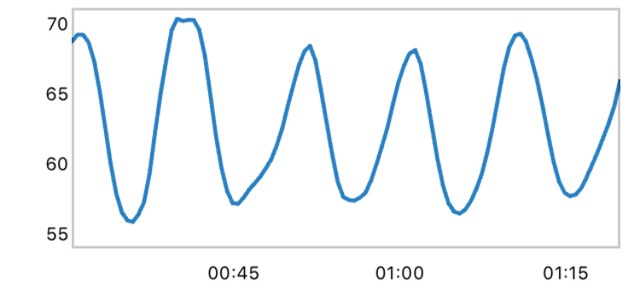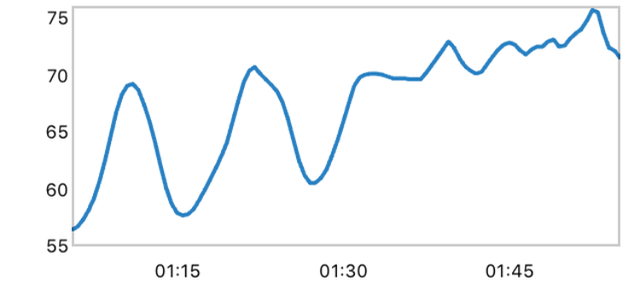Heart Rate Variability (HRV) is a measure of how much the beating of your heart varies. In normal resting state (meditation), my average heart rate is around 62 beats per minute, however it varies by ±10% based on my breathing:
- As I breathe in, my heart rate goes up (this is because expanding of the lungs make it slightly harder for blood to flow, so the heart speeds up a bit to compensate).
- As I breathe out, my heart rate goes down (this is called the downslope, where the deflating lungs give room and the heart can slow down).

Other factors that can influence my heart rate are stress, thoughts, emotions, and my body fighting something off (illness creeping in or I’m exposed to something I’m allergic to).
HRV coherence training
If only the breathing explains the variation in heart rate, this is named as “being in coherence” or “high coherence”. As only breathing seems to influence the heart rate, other heart rate varying factors seem to not be active in that moment.
Or in biological terms: your parasympathetic nervous system is running the show, and your body is in relaxed rest-and-breed mode.
Conversely, if the coherence is low, there are likely other factors influencing the heart rate besides the normal breathing. The one most likely factor is the activation of your sympathetic nervous system, i.e. your body’s flight/fight/freeze response is activated.

This makes “HRV coherence” an useful indication how much you are in your relaxed yet attentive state, so this is commonly used to make the quality of your meditation “measurable” (Inner Balance) and give feedback on stress levels (Lief).
I use HRV coherence with the Inner Balance for my morning ritual, with the additional hack of adding binaural beats.
HRV training for fitness
Your default resting heart rate, your current range of the heart rates, and especially how fast your heart rate goes back to normal after exercise, all are indicators of your fitness.
You can use this information to tweak your training schedule. I’m told that Mark Sisson’s Primal Endurance also uses this technique, although I have not myself looked into this (yet).
HR(V) for detection of upcoming sickness or allergy
Your heart rate also raises when your body is fighting pathogens or substances it is allergic to. I track my resting heart rate as an indicator of my health. If it is higher than my daily average 68 beats/minute in the morning, I’ll add some extra vitamin C and glutathione to my daily intake.
Ingested allergens create a fairly quick (20-40 minutes) response from the body (5-15 beats/minute higher resting rate indicating that your body is ‘fighting off’ the allergen). The Food detective app leverages that to see if you have food sensitivities (however it requires you to stay still and calm during the ±60 minutes measurement time, which doesn’t fit my full lifestyle well).
Limitations of HRV
High HRV coherence matches well with detachment-style meditations
If rest and all other influencers kept equal, HRV coherence is a pretty good indicator of how much the slowing down parasympathetic nervous system is running the show or not. If you are using HRV coherence to determine whether you are meditating “correctly”, as popular in the bio-hacking community, you are choosing meditations that target as the goal low activation (i.e. of the Zen detachment style, or what Meditate.io calls “concentration meditation”).
HRV with other meditation styles
- Moving meditations, for example a walking meditation or tai chi, introduce measurement noise of the movement and associated exertions, and will give a low coherence even as you are doing it “perfectly”.
- Meditations aiming to welcome emotions and fully emotionally feel them (what Meditate.io calls “Inquiry meditation”), will actually have higher activation of your para-sympathetic nervous system due to those emotions. So even as you are diving deep into your emotions without attachment, you’ll have a low coherence score.
- Meditations aiming to be fully present with (intense) physical sensations, such as tantric practices and OMing, will also have low coherence as due to the physical arousal your body will have less coherence.
- Mantra-speaking meditation, might give a high coherence if the breathing pace is accurately and standardly set.
Lag in determining coherence
As HRV is the variation between heart rate and the heart beats approximately once per second, it takes at least several seconds to have enough data to accurately determine that the heart rate is changing. To further determine that this is not a temporary fluke, takes several additional breaths (of 5-15 heart beats in my case). Thus, just from the logistics in measuring of data, any coherence algorithm will have a lag of half a minute or more.
This means that when say the Inner Balance app starts signaling dropping into a lower coherence class, the cause of that is probably about half a minute or so back. On a call with the Bulletproof® Coach training, the Heartmath people indicated they estimated it to be at 20+ seconds. I’d put it more at 30+ seconds.
Utilizing heart rate as the only data point has some limitations
Systems that measure HRV utilizing heart rate as the only data point (e.g. Inner Balance or chest straps without other sensors) estimate your breathing frequency from the variation of the heart rate itself.
This bootstrapping means that these systems are a bit slower in determining you are in coherence if you don’t follow their breathing instructions, and can get confused if for other reasons your breathing speeds up (exercise for example)
For further reference:
- Inner Balance (Heartmath): HRV coherence feedback for meditation, using an earclip blood measurement.
- Lief: HRV coherence feedback for anxiety and authentic relating. Has motion sensors for faster acquisition of HRV coherence, and vibration motor for intuitive haptic feedback.
- Bulletproof® Food detective app
